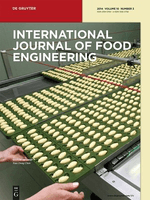
International Journal of Food Engineering
Scope & Guideline
Advancing Food Innovation through Engineering Excellence
Introduction
Aims and Scopes
- Food Processing Technologies:
Research on various food processing methods, including thermal and non-thermal technologies, evaluating their effects on food quality, safety, and sensory attributes. - Food Quality and Safety:
Investigations into the physicochemical properties of food products, methods for detecting food adulteration, and approaches to enhance food safety and shelf life. - Sustainable Practices in Food Engineering:
Studies focused on sustainable food production and processing practices, including waste reduction, resource optimization, and the use of eco-friendly materials. - Innovative Materials and Packaging:
Research on the development of new materials for food packaging and preservation, including biodegradable and active packaging solutions. - Food Microbiology and Biochemistry:
Explorations into the microbiological and biochemical aspects of food, including fermentation processes, enzyme activities, and the impact of microorganisms on food quality. - Sensory and Nutritional Evaluation:
Studies assessing the sensory properties and nutritional value of food products, including the impact of processing methods on these attributes.
Trending and Emerging
- Nanotechnology in Food Applications:
Research on the application of nanotechnology for food safety, preservation, and detection of food adulterants is on the rise, highlighting the potential for advanced solutions in food engineering. - Sustainable Food Systems:
Investigations into sustainable practices, including waste reduction and resource-efficient processing methods, are increasingly prominent, aligning with global efforts to enhance food security and minimize environmental impact. - Smart Food Packaging and Preservation Techniques:
Emerging studies on intelligent packaging systems that monitor food freshness and enhance shelf life through active and smart technologies are gaining attention. - Food Safety and Quality Enhancement:
An increasing focus on innovative methods to ensure food safety, such as advanced detection technologies and quality assessment techniques, is evident in recent publications. - Functional Foods and Health Impact Studies:
Research exploring the health benefits of food products, including the role of bioactive compounds and dietary fibers in disease prevention, is becoming more prevalent.
Declining or Waning
- Traditional Food Processing Methods:
Research focused on conventional food processing techniques has decreased, likely due to the increasing emphasis on innovative and sustainable methods that offer improved efficiency and quality. - Single Ingredient Studies:
There has been a waning interest in studies that focus solely on single ingredients, as the field shifts towards more complex formulations and interactions between multiple components. - Basic Nutritional Studies:
Research that merely describes the nutritional content of foods without exploring the implications for health or processing is appearing less frequently, as the focus turns towards functional foods and health impacts.
Similar Journals
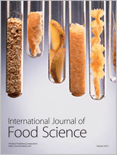
International Journal of Food Science
Delivering Cutting-edge Insights in Food ScienceThe International Journal of Food Science, published by HINDAWI LTD, stands as a crucial platform for advancing knowledge within the realm of food science. Established in 2013, this Open Access journal based in Egypt has garnered significant recognition, achieving an impressive Q2 classification in the 2023 Food Science category, which reflects its commitment to quality and impactful research. With a Scopus rank of #88 out of 389 in Agricultural and Biological Sciences and placing in the 77th percentile, this journal serves as an essential resource for researchers, professionals, and students dedicated to innovative developments and scientific exploration in food science. The journal not only provides unrestricted access to valuable research but also aims to foster collaboration and dissemination of knowledge on critical issues affecting food safety, nutrition, and technology. For those looking to keep abreast of the latest advancements, the International Journal of Food Science is certainly an indispensable addition to their academic pursuits.

FOOD REVIEWS INTERNATIONAL
Elevating Standards in Food Safety and ProcessingFOOD REVIEWS INTERNATIONAL, published by Taylor & Francis Inc, serves as a pivotal resource within the fields of Food Science and Chemical Engineering. Established in 1985, this esteemed journal offers a comprehensive platform for the dissemination of critical reviews that enhance understanding and innovation in the food industry. With an impressive impact factor reflecting its Q1 quartiles in both Food Science and Chemical Engineering categories, it ranks among the top journals in Scopus, securing the 24th spot in Agricultural and Biological Sciences. Scholars, researchers, and professionals are encouraged to explore its rich content, which spans meticulously reviewed articles that bridge academic research and practical applications, while contributing to advancements in food safety, processing, and sustainability. Although not an Open Access journal, access to its extensive repository is vital for anyone aiming to stay at the forefront of food science advancements.
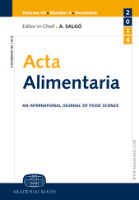
ACTA ALIMENTARIA
Elevating knowledge in food microbiology and safety.ACTA ALIMENTARIA is a renowned journal in the field of food science, published by AKADEMIAI KIADO ZRT, based in Hungary. Since its inception in 1973, it has served as a vital platform for disseminating high-quality research on food chemistry, microbiology, nutrition, and technology, contributing significantly to the advancement of knowledge in the agricultural and biological sciences. Currently classified in the Q3 quartile of the 2023 Food Science category, the journal is positioned to address pressing issues pertaining to food safety, quality, and sustainability, making it an invaluable resource for researchers, professionals, and students alike. Although it does not currently offer open access, the journal maintains a strong reputation with a readership keenly interested in the latest developments in food science. With a Scopus rank placing it in the 38th percentile of its category, ACTA ALIMENTARIA continues to be a pivotal reference for those engaged in food research and innovation.
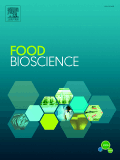
Food Bioscience
Innovating Solutions for a Sustainable Food FutureFood Bioscience is a leading peer-reviewed journal published by Elsevier, dedicated to advancing the understanding of the complex interplay between food science and biosciences. With an impressive Impact Factor that places it in the Q1 and Q2 quartiles for Food Science and Biochemistry respectively, the journal consistently ranks among the top publications in its field, reflected in its Scopus rankings (Rank #83/389 in Food Science and Rank #175/438 in Biochemistry). Since its inception in 2013, Food Bioscience has fostered a multidisciplinary approach, bridging gaps between research in agricultural, biological, and food sciences, thus encouraging innovative solutions to the pressing challenges facing the global food supply chain. Although it currently operates under a subscription model, the journal is committed to disseminating high-quality research, making significant contributions to both academic scholarship and industry practices. Researchers, professionals, and students alike are invited to explore the wealth of knowledge contained within its pages as it plays a pivotal role in shaping the future of food bioscience.
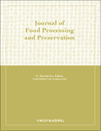
JOURNAL OF FOOD PROCESSING AND PRESERVATION
Advancing Food Science through Innovative ResearchJOURNAL OF FOOD PROCESSING AND PRESERVATION, published by Wiley-Hindawi, stands as a vital resource within the fields of Food Science, Chemical Engineering, and Chemistry. With an ISSN of 0145-8892 and an E-ISSN of 1745-4549, the journal has been a beacon of knowledge since its inception in 1977, continuing to provide valuable insights to the research community until 2024. Recognized for its quality, it holds a noteworthy Q2 ranking in 2023 across multiple categories, including Food Science and Chemical Engineering, indicating its influential contribution to the academic discourse. Although it offers no open access, the journal remains a crucial platform for disseminating groundbreaking research and innovative methodologies in food processing and preservation. Researchers, professionals, and students can significantly benefit from its comprehensive reviews, original research articles, and case studies, aimed at advancing knowledge and practices in food technology. By bridging the gap between theoretical advancements and practical applications, the JOURNAL OF FOOD PROCESSING AND PRESERVATION plays an essential role in addressing global food safety, sustainability, and quality challenges.

Food Engineering Reviews
Elevating Standards in Food Engineering through Comprehensive Reviews.Food Engineering Reviews is a prestigious journal published by SPRINGER, dedicated to advancing the field of food engineering through comprehensive review articles that synthesize current research and innovative practices. With an ISSN of 1866-7910 and an E-ISSN of 1866-7929, this journal serves as a vital resource for researchers, professionals, and students interested in the intricacies of food processing, preservation, and engineering techniques. Notably, the journal holds an impressive Q1 ranking in the category of Industrial and Manufacturing Engineering as of 2023, and it is positioned in the 94th percentile within its field according to Scopus rankings, highlighting its significance within the academic community. Although it does not offer open access, the rigorous content published in the journal from its inception in 2009 through to 2024 plays a crucial role in shaping practices that promote efficiency and sustainability in food engineering. The journal aims to foster knowledge exchange among scholars and industry experts, ensuring that emerging trends and foundational research are accessible to those striving towards excellence in food technology.

International Food Research Journal
Bridging Disciplines in the World of Food ResearchThe International Food Research Journal, published by UNIV PUTRA MALAYSIA PRESS, serves as a pivotal platform for disseminating innovative research within the field of food science. With an ISSN of 1985-4668 and an E-ISSN of 2231-7546, the journal has successfully established its presence since its inception in 2007, converging its findings through 2024. This esteemed journal holds a Q3 ranking in Food Science, illustrating its valuable contributions to the field as demonstrated by its Scopus rank of 276 out of 389, placing it in the 29th percentile among its peers in Agricultural and Biological Sciences. Although it operates under a traditional publishing model, its academic integrity and focus on high-quality research ensure that it remains a vital resource for researchers, professionals, and students eager to explore advances in food technology, nutrition, and safety. By encouraging interdisciplinary collaboration and critical dialogue, the International Food Research Journal plays an essential role in shaping the future of food science research.
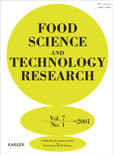
FOOD SCIENCE AND TECHNOLOGY RESEARCH
Transforming Food Technology Through ScienceFOOD SCIENCE AND TECHNOLOGY RESEARCH, published by the Japanese Society of Food Science & Technology, is a pivotal journal that encompasses a wide spectrum of research in the fields of food science, biotechnology, and engineering. With its ISSN number 1344-6606 and a digital counterpart E-ISSN 1881-3984, this journal aims to disseminate cutting-edge research and innovative technologies that enhance food safety, quality, and sustainability. Recognized for its contributions, it holds a Q3 category ranking in multiple disciplines, including Food Science and Biotechnology, indicating a significant role in advancing academic discourse. Researchers and professionals can benefit from its insights, as the journal covers an array of topics relevant to industrial applications, marketing strategies, and scientific advancements. Although not an open-access journal, it has a wide reach and is committed to providing high-quality, peer-reviewed content essential for scholars and practitioners in the food science community from 1999 to 2024.

Food Chemistry-X
Advancing the Science of Flavor and Safety.Food Chemistry-X is a premier open-access journal published by Elsevier, dedicated to advancing the field of food chemistry through high-quality research and comprehensive reviews. With its ISSN of 2590-1575, the journal has gained significant attention since adopting an open-access model in 2019, allowing wide dissemination of knowledge and innovations in food science. Based in the United Kingdom, it holds prestigious Q1 rankings in both Analytical Chemistry and Food Science categories as of 2023, positioning itself as a leading platform for researchers worldwide. The journal's focus spans extensive topics within food chemistry, including food safety, nutritional analysis, and the chemical properties of food, offering insights that are crucial for addressing contemporary challenges in food production and consumption. With a Scopus rank placing it in the 65th percentile among the top journals in Food Science and the 58th percentile in Analytical Chemistry, Food Chemistry-X is an essential resource for academics, professionals, and students seeking to stay at the forefront of research and innovation in this vibrant field.
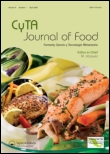
CyTA-Journal of Food
Innovating food technology through cutting-edge research.CyTA-Journal of Food is a prestigious academic journal published by TAYLOR & FRANCIS LTD, dedicated to advancing the field of food science and technology through the dissemination of innovative research and practical knowledge. With an ISSN of 1947-6337 and an E-ISSN of 1947-6345, this journal stands out with its strong impact factor and is currently placed in the Q2 quartile across multiple categories, including Chemical Engineering, Chemistry, and Food Science, making it a vital resource for researchers and professionals alike. The journal has been an integral part of the academic community since its inception in 2009, and continues to publish cutting-edge articles through to 2024. Its alignment with Scopus ranks further signifies its influence, notably achieving 67th percentile in Industrial and Manufacturing Engineering. As an Open Access journal, it ensures widespread accessibility to its valuable content, promoting collaboration and knowledge sharing among scientists, engineers, and students dedicated to enhancing food safety, quality, and sustainability.